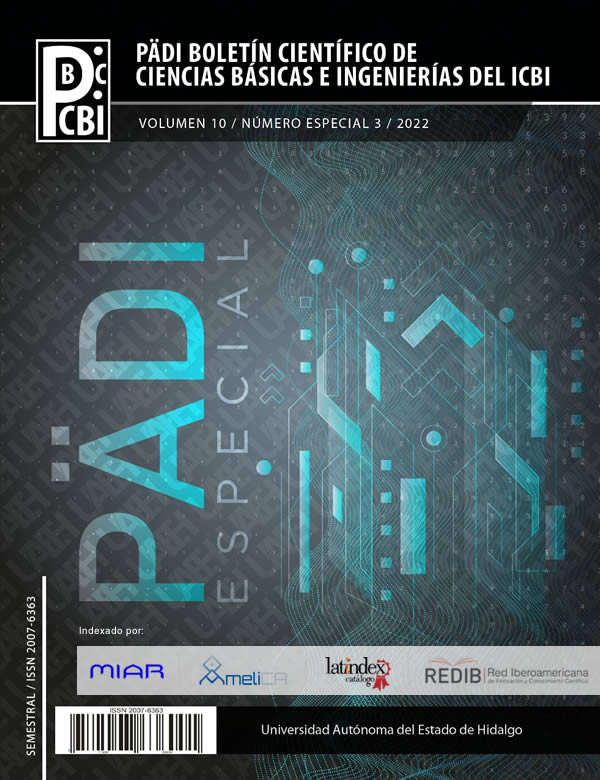Fabricación y caracterización eléctrica de diodos de unión p-n de arseniuro de galio
DOI:
https://doi.org/10.29057/icbi.v10iEspecial3.8991Palabras clave:
Diodos de unión, GaAs, Curvas IV, OrganometalesResumen
Se fabricaron diodos de unión p-n de arseniuro de galio por la técnica de depósito químico en fase vapor usando materiales organometálicos (MOCVD). Se caracterizaron y analizaron curvas de corriente eléctrica contra voltaje en polarización directa, I-V. Mediante las caracterizaciones eléctricas se comprobó la realización de la unión pn, esto es, las curvas I-V muestran un comportamiento exponencial, también de las curvas I-V se obtuvo el factor de idealidad. El factor de idealidad nos dice que mecanismos de conducción está ocurriendo en el diodo de unión p-n y, este mostró que los mecanismos de conducción se presentaron principalmente en la región de deserción o región libre de portadores de carga, lo cual es común en diodos fabricados de arseniuro de galio con un gran ancho de banda prohibida y baja concentración de portadores de carga en ambas capas tipo p y tipo n.
Descargas
Información de Publicación
Perfiles de revisores N/D
Declaraciones del autor
Indexado en
- Sociedad académica
- N/D
Citas
A. A. Bergh and P. J. Dean, (1976), Light-emitting diodes, Claredon, Oxford.
ByLev I. Berger, (1997), Semiconductor Materials, Edition 1st Edition First Published.
Castillo-Ojeda, R.; Galván-Arellano, M.; Díaz-Reyes, J., (2013), Crecimiento epitaxial de un pozo cuántico de AlxGa1-xAs/GaAs/AlxGa1-xAs utilizando vapores metalorgánicos y arsénico sólido como precursores, Superficies y vacío 26 (4).
Daniel W. Hart, (2001), Electronica de potencia, Prentice Hall, Pearson educación, S. A., Madrid.
D. M. Dobkin, M.K. Zuraw, (2003),Principles of Chemical Vapor Deposition, Springer-Science+Business Media, B. V.
H. C. Casey, Jr and B. (1978), Panish, Heteroestructure laser, academic, New York.
H. Sugawara, M. Ishikawa, and G. Hatakoshi, (1991), High‐efficiency InGaAlP/GaAs visible light‐emitting diodes, Appl. Phys. Lett. 58, 1010.
Jacob-Fraden, (2010), Handbook of modern sensors : physics, designs, and applications. 2nd ed. - Woodbury (New York).
J. E. geusic, F. W. Ostermayer, H. M. Marcos, L. G. Van Uitert J. P. Van Der Ziei, (1971), Efficiency od red, green and blue infrared -to-visible conversion sources, J appl Phys., 42, 1958.
Kajava T. T., Alexander L. Gaeta, (1996), Q switching of a diode-pumped Nd:YAG laser with GaAs, Optics Letters Vol. 21, Issue 16, pp. 1244-1246.
Kevin M. McPeak, (2010), Chemical Bath Deposition of Semiconductor Thin Films & Nanostructures in Novel Microreactors, Drexel University.
Manijeh Razeghi, (2011), The MOCVD Challenge: A survey of GaInAsP-InP and GaInAsP-GaAs for photonic and electronic device applications, Second edition, CRC Press Taylor and Frances Group 6000 Broken Sound Parkway N W, Suite 300.
M. Levinshtein, S. Rumyantsev, (1996), Handbook series on semiconductor parameters, world scientific Publishing Co. Pte. Ltd, P O Box 128, Farrer Road, Singapore 912805.
Paul E. Minton, (1986), Handbook of Evaporation Technology, Elsevier Science.
R. E. Davis and G. Gibbons, (1967), Design principles and construccion of planar Ge Esaki diodes, solid state electron., 10 461.
Risto S. Laitinen, Raija Oilunkaniemi, (2019), Selenium and Tellurium Reagents: In Chemistry and Materials Science, Walter de Gruyter GmbH, Bderlin/Boston.
Sadao Adachi, (2005), Properties of group III-V and II-VI semiconductors, Wiley series in materials for electronic and optolelectronic applications. John Wiley and sons, Ltd, The Atrium, Southern gate, Chichester, West Sussex PO19 8SQ, England.
S. Yoshida, S. Misawa, S. (1983), Gonda Improvements on the electrical and luminescent properties of reactive molecular beam epitaxially grown GaN films by using AlN-coated sapphire substrates. Applied Physics Letters, 48.
Udo W. Pohl, (2020), Epitaxy of Semiconductors: Physics and Fabrication of Heterostructures, second edition, Springer, Nature Switzerland AG.
W. Shockley, (1949), The Theory of p-n Junctions in Semiconductors and p-n Junction Transistors, Bell System Tech. J., The Bell System Technical Journal, 28, 3.
Z. Hurych, (1966), influence of nonuniform thickness of dielectric layer on capacitance and tunnel current, solid state electron. 9, 967.




















